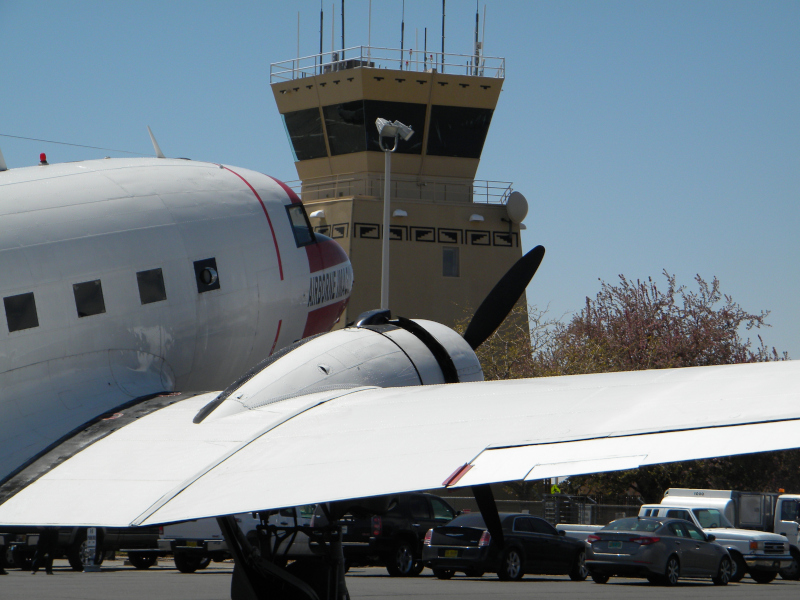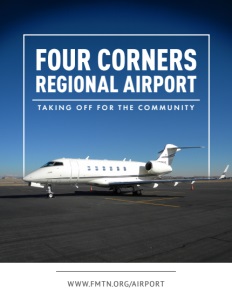Four Corners Regional Airport
Taking Off for the Community
Expertly driving economic development and aviation education in San Juan County.
Four Corners Regional Airport (IATA: FMN) is a pivotal hub for general aviation and military operations in the San Juan County region located in Farmington, New Mexico. This Class D towered airport, perched at an elevation of 5,506 feet, boasts two asphalt runways, 5/23 and 7/25, measuring 6,501 feet and 6,704 feet, respectively, each well-equipped to handle a variety of aircraft. The airport provides comprehensive services, including aircraft rescue and firefighting, air traffic control, and a fixed-base operator (FBO), offering amenities such as hangar space, aircraft maintenance, in-flight catering, and a flight crew lounge.
Mike Lewis, the Airport Manager, offers an update on a recent project. “We don’t have a date for SkyWest to come in yet,” he shares, reflecting the uncertainties that hover over potential developments. “We’re in ongoing negotiations, but certain things must fall into place.”
A significant disruption came from an unexpected quarter—Boeing’s delay in delivering aircraft due to issues with a door on an Alaska Airlines plane. This delay has a ripple effect, impacting airlines like SkyWest, which partners with major carriers such as American, Delta, and United. “SkyWest’s interest in our market has been eclipsed for now because they’ve had to cover for these delays,” Lewis explains.
The challenges faced by Four Corners are not isolated. “Southwest Airlines closed four cities and laid off 2,000 people,” Lewis notes, pointing out the broader impact of the aircraft delivery delays. This kind of upheaval is unprecedented in Southwest’s history and is directly tied to the logistics of airplane leasing and the cascading effect of delayed new deliveries.
Reflecting on the past, Lewis recalls, “In May 2020, SkyWest had given us an offer to start service. The city council approved it, and the mayor signed it.” However, the optimism of that period quickly faded as the reality of the COVID-19 pandemic set in. By June and early July, it was clear that the recovery of air travel was not as swift as hoped. “We decided to wait for a more opportune time,” he says, noting that federal grant money is available to help launch the service, but it’s a one-time opportunity that needs to be used wisely.
Tracking air traffic data is a critical part of their strategy. Lewis points out, “Before COVID, TSA was screening between 2.2 and 2.7 million people a day in the U.S. At the height of the pandemic, that number plummeted to 87,000 in one day.” This stark drop highlights the dramatic impact on the industry, which has only been slowly recovering. Despite the positive trend in increasing passenger numbers, the market has plateaued at about 40% of its pre-COVID levels.
In the current climate, airlines have found a way to maintain profitability despite limited capacity. “The airlines are making $8 billion more monthly than last year,” says Lewis. This windfall comes from raising fares on fully booked flights, a clear case of supply and demand. “Airfares are not coming down,” he remarks. “When the plane is full, and there’s no spare aircraft, the only option is to raise the fare.”
Capital Improvements and Safety Enhancements
Four Corners Regional Airport is looking to expand its services and is deeply invested in enhancing its infrastructure to meet modern aviation standards. Lewis highlights a significant development:
“We’ve reconstructed much of the airfield to handle regional jets, and there’s extra funding from the Build Back Better program.” This additional federal funding from the FAA is crucial. “We’ve put in to overhaul our main runway,” he states, referring to their plans to mill and overlay the east-west runway, a critical upgrade to support future growth.
The project includes installing new LED lighting. “That will make the airport almost 100% LED-lit,” Lewis notes enthusiastically. The benefits are multifaceted: LEDs are brighter, clearer, and more cost-efficient. “It takes much less power to operate an LED light and get the same brilliance,” he adds, emphasizing operational efficiency and improved visibility for pilots.
The airport’s accolades also play a role in its development trajectory. In 2018, Lewis was awarded for being the best airport manager, which has had a ripple effect on his career and the airport’s reputation. “It brings recognition within my peer group,” he says. The FAA’s acknowledgment of the airport’s standards further cements its status. “The inspections have always been easy to go through because their findings are so minimal,” Lewis mentions, owing to the rigorous maintenance and operational protocols.

Safety Upgrades and General Aviation Growth
Safety remains a top priority, and several upgrades reflect this. “We’ve reconfigured our taxiways to a 90-degree angle from the runway,” explains Lewis. This change significantly reduces the risk of accidental runway incursions. They’ve also upgraded the visual approach slope indicator system to a state-of-the-art PAPI system, ensuring precise approach guidance.
Furthermore, enhancing the runway safety area has been a critical focus. “We extended the area off the pavement to a specific degree of slope, guaranteed to be obstacle-free,” Lewis outlines. This modification ensures that any aircraft leaving the pavement will have a smooth and safe stop.
Another noteworthy improvement involves moving the taxiways further away from the runway. “This reduces the likelihood of involvement in any accidental runway departure,” he says, highlighting the foresight in planning these safety measures.
General aviation at Four Corners Regional Airport has seen remarkable growth. “We’ve gone from 33,000 operations in 2016 to 52,000 in 2023,” Lewis points out. Despite a slight dip during the COVID-19 pandemic, this growth indicates a robust upward trend in airport activity.
Tourism and Development Opportunities
Four Corners Regional Airport’s strategic position as the fourth largest airport in New Mexico is a significant asset that extends beyond aviation. It creates avenues for tourism and commercial development, pivotal for the region’s economic growth.
“We have about 120 acres on the north side of the airfield,” Lewis explains, discussing the potential for future development. The vision includes aviation-related projects such as hangars and overhaul facilities, but the possibilities extend further. “The remainder of that property wouldn’t have as much restriction on how it could be developed.”
However, accessing this land presents challenges. “The airport is located on a mesa,” he details. The terrain’s steep drop at both runway ends complicates building a road around the runway to the north side. Discussions are underway to develop a right of way or acquire property to facilitate this access.
Tourism, another vital area, sees a substantial impact from the airport’s operations. “There’s been about a 12 to 15% increase in GA flights,” notes Lewis, attributing this to the rise in private flights. He cites multiple attractions drawing visitors to the area. “New Mexico is working to attract outdoor recreation as a tourist destination,” he says, highlighting efforts to increase awareness of the state’s offerings. A prime example is the world-renowned fly-fishing waters on the San Juan River, attracting global enthusiasts.
Additionally, the region is rich in archaeological sites, home to ancient Native American cultures. “We have several archaeological sites around this region,” says Lewis, pointing out that some of these sites date back to before the time of Christ. This historical wealth is complemented by the discovery of dinosaur fossils and petrified wood, with one of the only full-size fossilized skeletons of a baby Tyrannosaurus rex found in the Bisti Badlands.
The airport’s proximity to Colorado further enhances its appeal. “People can enjoy fishing and rafting,” he notes, adding that Navajo Lake offers boating adventures, fishing, and camping. This abundance of outdoor activities contributes to the influx of aircraft, with many visitors staying for extended periods. “We’re getting a lot of aircraft coming in, some of them jets, some of them large turboprops,” Lewis observes. These visitors include business travelers and tourists, often drawn by the area’s recreational opportunities.
The region’s natural beauty and cultural heritage also surprise many newcomers. “I remember living on the East Coast and thinking New Mexico was all saguaro cactus and dunes,” Lewis reminisces. Instead, the area boasts snow, skiing, and a wealth of archaeological and cultural sites. Chaco Canyon, in particular, stands out. “There are massive remnants of buildings, and they understood solar patterns and astronomy,” he says, explaining how ancient structures align with celestial events.
Furthermore, the area’s designation as a national park site makes it ideal for astronomy events. “There’s zero light pollution,” Lewis points out, making it a prime location for stargazing and astronomical research. The combination of these factors makes the region around Four Corners Regional Airport a burgeoning hub for both tourism and commercial development.

Future Priorities: Education and Infrastructure
Looking ahead, Four Corners Regional Airport is poised to tackle several ambitious projects that will shape its future over the next 18 months. These initiatives focus on enhancing infrastructure and fostering a new generation of aviation professionals.
“We believe we’re going to get the funding to overhaul this runway,” says Lewis. This major project, expected to span 60 to 70 days, will consume significant time and resources. In addition to the runway project, Lewis mentions pursuing the establishment of an avionics repair station. “There are so few avionics shops in this area,” he explains. “I’m sure it would boom and benefit the community and the entire region.” Currently, aircraft owners must endure long wait times and travel to Alamosa, Colorado, or Albuquerque for avionics work.
The shortage of aviation-related technicians is a critical issue. “There’s a critical shortage of aviation-related technicians of all fields,” Lewis emphasizes. To address this, the airport has proactively engaged with local high schools to introduce the Aircraft Owners and Pilots Association (AOPA) STEM program.
“This four-year STEM program is incredible,” Lewis says, detailing the comprehensive curriculum designed to inspire high school students. The program targets students at a critical stage, providing aviation-related STEM courses during their first and second years. “It’s geared towards allowing them to speak aviation lingo,” he explains. As juniors and seniors, students can branch into specialized instruction, focusing on engineering, piloting, mechanics, and drone operation.
The program’s affordability is a key factor in its appeal. “The cost is like $2,000 to $3,000 a semester for the school, which is pennies,” Lewis points out. This low cost makes the program accessible and ensures it can reach a broad demographic, including the 33% Native American population in the local school system. “This will help maybe grab a bunch of those young folks and give them the enthusiasm to follow through,” he says, highlighting the potential impact on underrepresented groups.
This combination of infrastructure improvements and educational initiatives at Four Corners Regional Airport highlights a forward-thinking approach to fostering growth and opportunity in the region.
AT A GLANCE
Four Corners Regional Airport
What: Regional airport driving economic and educational growth
Where: San Juan County, New Mexico
Website: https://fmtn.org/airport
PREFERRED VENDORS
Visit Farmington – https://farmingtonnm.org/
Discover Farmington, New Mexico, where adventure meets charm! Surrounded by breathtaking landscapes, we turn every visit into a vibrant experience. From scenic trails to local delights, Farmington is your playground for fun and relaxation. Unleash your inner explorer with us—every day is an adventure!



